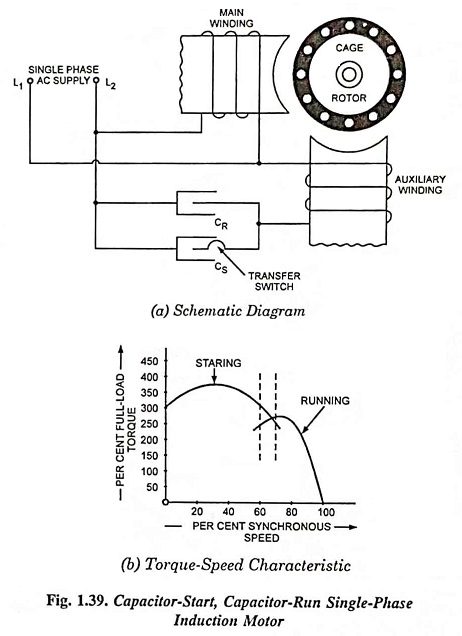Capacitor-Start Capacitor-Run Single Phase Induction Motor:
The capacitor-start capacitor-run motor is similar to capacitor-start, induction-run motor, except that the auxiliary winding and a capacitor remain connected in the circuit at all times. Of course, such as motor consists of two different capacitors—one small value oil impregnated paper continuous rating capacitor CR and another much larger value electrolytic short-duty capacitor CS, as illustrated in schematic diagram given in Fig. 1.39 (a).
Such a motor operates as a two-phase motor from single phase supply, thereby, producing a constant torque and not a pulsating torque, as in other single-phase motors. Besides their ability to start heavy loads they are extremely quiet in operation, have better efficiency (55-65%) and power factor (0.8-0.95) when loaded and develop up to 25% greater overload capacities. They are indeed splendid machines where the load requirements are severe as in case of compressors, refrigerators and fire stokers, pumps, conveyors etc. The disadvantage of such machines is only high cost. These motors are often employed requiring a quiet operating motor such as in hospitals, studios etc.
In recent years, home air-conditioners have become extremely popular. In many cases, the electrical system in the home may not have the capacity to handle the electrical load of the air-conditioner(s). For this reason, these motors have found more wide spread use in the compressors. Both the starting and running currents are low full-load current may be 3/4th of that for an equivalent capacitor-start motor.
Applications:
Such motors have become increasingly popular and are now manufactured in the larger sized single-phase motors where previously only repulsion-start motors were available. A typical torque-speed characteristic is shown in Fig. 1.39 (b). The direction of rotation of motor may be reversed by interchanging the connections to the supply of either the main or auxiliary winding.
